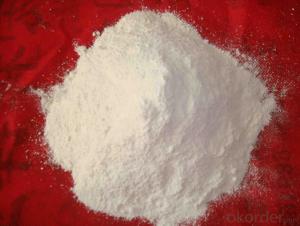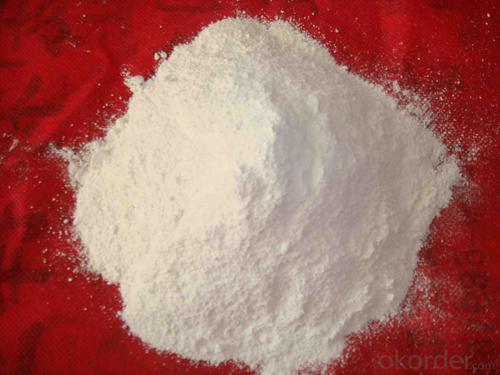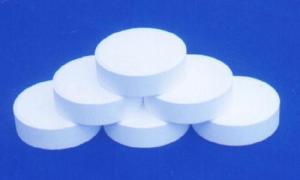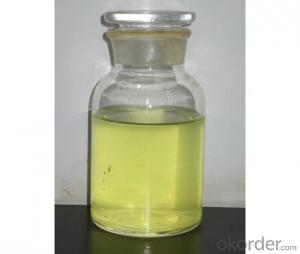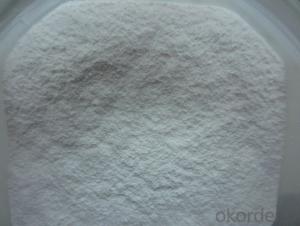white carbon black (SiO2) / silica dioxide - enhanced tear strength and abrasion resistance
- Loading Port:
- Qingdao
- Payment Terms:
- TT OR LC
- Min Order Qty:
- -
- Supply Capability:
- 20000 m.t./month
OKorder Service Pledge
OKorder Financial Service
You Might Also Like
Specifications
Cas no.:7631-86-9
Product: silica / white carbon black/ SiO2
Production process: precipitated, fumed
Capacity: 25000 MT/a
CAS no.:7631-86-9
Product: silica / white carbon black/ SiO2
Production process: precipitated, fumed
Color: white
Appearance: powder or granular
Packing: 10kg/bag, 20kg/bag, per your need, with or w/o pallets
Capacity: 25000 MT/a
Payment: T/T, L/C, DA, DP, etc
Shipment: 2 weeks after your confirmed order
SiO2 / Silica/ White Carbon Black MAIN SPEC:
Main Item | Spec |
BET | 110~210 (110~ 130, 140~160 , 170-190, 180-210) m2/g |
DBP | 200~ 350 ( 200~260, 240~280, 240-350, 250-310) mL/100g |
Loss on drying (105°C) | 8% max |
PH (5% sol) | 6~8 |
SiO2 | 90% min |
Specific product OF SiO2 / Silica/ White Carbon Black for Rubber:
With special physic-chemical properties, Precipitated silica work as reinforcing transparent fillers highly valued in formulation of rubber-based blends, lead to enhanced tensile strength, tear strength and abrasion resistance and increase hardness of vulcanized rubbers, reduce consumption of rubbers and therefore reduce the cost.
Main spec:
Main Item | Spec |
BET | 140~160 m2/g |
DBP | 240~280 mL/100g |
Application:
1) SiO2 / Silica/ White Carbon Black For Light-colored, color and High-grade transparent rubber products.
2) SiO2 / Silica/ White Carbon Black For PE, PP, powder products as filler with good fluidity property
3) SiO2 / Silica/ White Carbon Black As food additives, feed additives, Pesticide carrier with good fluidity and anti-caking property
4) SiO2 / Silica/ White Carbon Black For glass cement, sealant, painting, coating, printing ink, as thickener and Anti precipitating agent
5) SiO2 / Silica/ White Carbon Black for others
Storage: dry, clean, ventilated space
Any help from us, please contact freely! NICE DAYS !
- Q: Does the catalyst participate in chemical reactions?
- In fact, my understanding is to participate in the reaction, but in the whole process of reaction is both a reactant and a product. But in the reaction process is to participate.
- Q: Can Cuo react as a catalyst with H2O2, does its quality and chemical properties change?
- 2H2O2 (CuO catalyzed) ====== 2H2O + O2 ↑
- Q: Will the catalyst change the reaction rate in the chemical reaction?
- Many of the catalysts are specific in varying degrees, and when added to the chemical reaction system that it can catalyze, it must change the rate of chemical reaction, and of course both positively and negatively catalyzed. Chemical reaction rate, it can not be called a catalyst.
- Q: Is the catalyst in the chemical reaction better?
- The efficiency of the catalyst is very high, as long as a little bit on it, with too much in addition to increase the cost of meaningless. Positive catalyst can increase the rate of several thousand times. Fast ... I know there will be about a thousand years shortened to 1 second. There are slowdown in the catalyst, people taught not learned. Other versions of the textbook is not clear. Should not learn.
- Q: what is a catalyst?
- a catalyst is a substance that affects the rate of rxn without actually being consumed in the rxns . a catalyst doesnt become a part of the products. catalystss are of two types 1 POSITIVE CATALYST . it increases the rate of rxn . that is the products are formed faster . eg sunlight in a photochemical rxn is a positive catalyst 2 NEGATIVE CATALYST - which slow down a rxn . like addition of glyceriene to hydrogen peroxide slows down its decomposition
- Q: Can chemical reaction limits be changed by catalyst or other methods?
- Do not know what you say is the limit of the concept of reaction. The general catalyst can change the rate of the reaction, most of which is used to speed up the reaction rate, that is, it will be difficult to react or normally does not respond to the material to provide a reaction of the bridge, so that the material through the catalyst to establish a connection to achieve the reaction the goal of.
- Q: When you write a chemical equation, how do you want to add "catalyst" and "?" When you do not have to write?
- This is the need for your memory, write a few times, will naturally cooked
- Q: Does the nature and quality of the catalyst itself change before and after the chemical reaction?
- A catalyst will induce a chemical reaction to change, leaving the chemical reaction faster or less
- Q: What is the catalyst called?
- Catalysts induce chemical reactions to change, cause chemical reactions to become faster or slower, or to react chemically at lower temperatures. The catalyst is also known as a catalyst in industry.
- Q: Can you describe at least 4 ways a catalyst can lower the activation energy of a reaction?
- To see how a catalyst accelerates the reaction, we need to look at the potential energy diagram shown below which compares the non-catalytic and the catalytic reaction. For the non-catalytic reaction, the figure is simply the familiar way to visualize the Arrhenius equation: the reaction proceeds when A and B collide with succificient energy to overcome the activation barrier. The change in Gibbs free energy between reactants, A + B, and the product P is delta G. The catalytic reaction starts by bonding of the reactants A and B to the catalyst, in a spontaneous reaction. Hence, the formation of this complex is exothermic and the free energy is lowered. There then follows the reaction between A and B while they are bound to the catalyst. This step is associated with an activation energy; however, it is significantly lower than that for the uncatalyzed reaction. Finally, the product P seperates from the catalyst in an endothermic step. The energy diagram illustrates 4 ways the catalyst works : The catalyst offers an alternative path for the reaction that is energetically more favorable The activation energy of the catalytic reaction is significantly smaller than that of the uncatalyzed reaction; hence the rate of the catalytic reaction is much larger The overall change in free energy for the catalytic reaction equals that of the uncatalyzed reaction. Hence, the catalyst does not affect the equilibrium constant for the overall reaction. A catalyst cannot change the thermodynamics of a reaction but it can change the kinetics. The catalyst accelerates both the forward and the reverse reaction to the same extent. In other words, if a catalyst accelerates the formation of product P from A and B, it will do the same for the decomposition of P into A and B.
Send your message to us
white carbon black (SiO2) / silica dioxide - enhanced tear strength and abrasion resistance
- Loading Port:
- Qingdao
- Payment Terms:
- TT OR LC
- Min Order Qty:
- -
- Supply Capability:
- 20000 m.t./month
OKorder Service Pledge
OKorder Financial Service
Similar products
Hot products
Hot Searches
